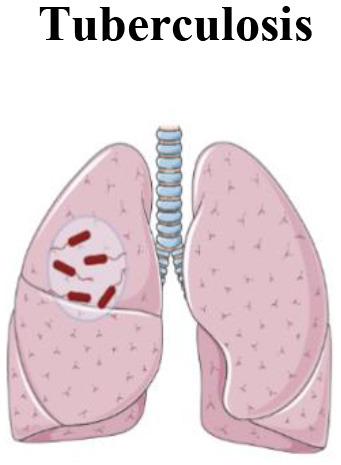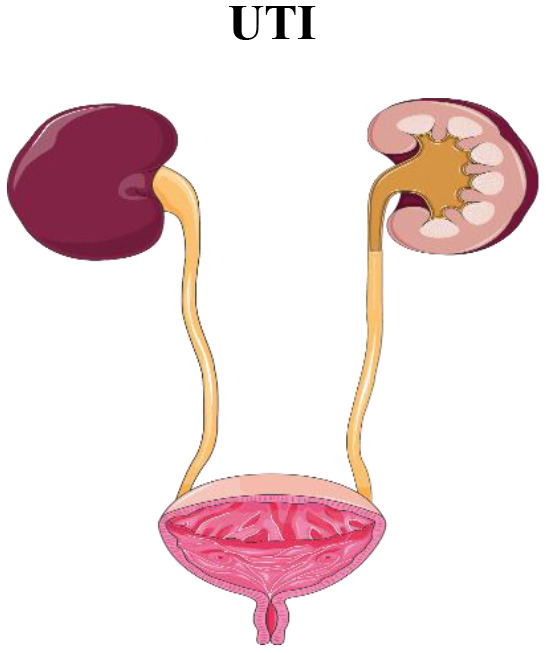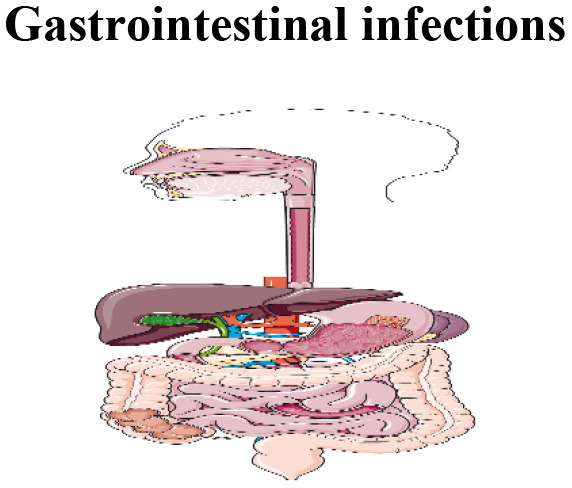Table 2.
Schematic view of clinical usage of ciprofloxacin.
| Infection | Notes | References |
|---|---|---|

|
MIC of ciprofloxacin against Mtb ranges between 0.5 and 1 mg/L, and a single oral 750-mg dose of ciprofloxacin has been shown to produce a serum level of 2.01 mg/L, with a bronchial tissue level of 4.86 mg/kg | (39) |
| Ciprofloxacin may be effective in treating Mtb, especially in patients with HIV infections and MDR-TB, in combination with other anti-mycobacterial drugs | (40) | |
| According to WHO consolidated guidelines on tuberculosis, ciprofloxacin is no longer recommended for treating drug-resistant Mtb | (41) | |
| Mtb sensitivity to ciprofloxacin can be decreased after short exposure courses, which makes this drug ineffective in treating Mtb | (42) | |

|
The CDC declared that ciprofloxacin is no longer recommended for the treatment of gonorrhea | (43) |

|
A combination of ciprofloxacin with rapidly acting antimalarial agents such as mefloquine can be a valuable treatment for resistant Plasmodium falciparum infections | (44) |

|
Ciprofloxacin is the most commonly prescribed FQ for the empirical treatment of UTIs because of its availability in oral and intravenous forms | (45, 46) |
| Ciprofloxacin is effective for treating acute uncomplicated cystitis in 3-day regimens. However, having a propensity for side effects suggests using ciprofloxacin for more important diseases and considers it an alternative drug for acute cystitis | IDSA guideline (2010 update) | |
| For treating acute pyelonephritis, an oral 500-mg dose of ciprofloxacin twice a day for seven days with or without an intravenous 400-mg of ciprofloxacin is recommended in regions with <10% of uropathogens resistance | (47) | |
| Considering the adverse reactions of ciprofloxacin, FDA has recommended not to use ciprofloxacin for uncomplicated UTIs when other choices are available | (48) | |
| During the last decade, the resistance of uropathogens against ciprofloxacin has increased. In a 10-year follow-up of E. coli, a significant increase in ciprofloxacin resistance from 1.8 to 15.9% was observed | (49) | |
| Ciprofloxacin ER, a once-daily formulation with delayed release, achieves a higher Cmax and has more rapid bacterial killing, which makes it a valuable option for treating out-patient UTIs | (50) | |

|
Ciprofloxacin is effective against the most frequent bacterial respiratory pathogens such as H. influenzae, S. pneumoniae, M. catarrhalis, and P. aeruginosa and can be used to treat complicated and severe lower respiratory tract infections | (51) |
| Ciprofloxacin can be used for treating pneumonia (mainly nosocomial), and chronic bronchitis, as well as CF | (51) | |
| A combination of oral ciprofloxacin with a nebulized antibiotic* (is suggested as first-line therapy), and a 2-week treatment of ciprofloxacin for CF patients who are chronically infected with P. aeruginosa is recommended | (52) | |
| Ciprofloxacin dry powder inhaler was developed for targeted lung delivery, which achieves a high concentration of ciprofloxacin in the lungs with low systemic exposure | (51, 53) | |

|
Ciprofloxacin has great mucosal tissue levels and low MICs against Helicobacter pylori, but it has failed to eradicate this bacterium because of reduced antibiotic activity in a low pH environment and increased ionization and gastric mucus trapping of ciprofloxacin | (54) |
| Ciprofloxacin is the critical choice for treating adult patients with typhoidal and severe non-typhoidal salmonellosis with spreading infection beyond the intestinal tract | (55) | |

|
Administration of an oral 750–1,000 mg dose of ciprofloxacin every 12 h can cure most cases of Gram-negative osteomyelitis or mixed infections with S. aureus Concerning the increasing rate of resistance against ciprofloxacin, this antibiotic should not be used for the treatment of simple SSTIs but should be reserved for patients with allergies to β-lactams |
(56) (57) |

|
Topical ciprofloxacin has the advantages of direct contact with infected tissue, excellent empiric coverage, non-ototoxicity, and no risk of musculoskeletal complications, which often are associated with systemic use | (58) |
| Overuse has increased the prevalence of ciprofloxacin-resistant otologic infections in recent years, which can cause serious challenges in treating ear infections due to the limited options for topical therapy | (59) | |
| The results of a study indicated that ciprofloxacin was ineffective for treating ciprofloxacin-resistant infections, and other alternatives should be explored | (59) | |
| The results showed that ciprofloxacin was the most effective antibiotic for the treatment of CSOM, with 93.7% sensitivity of P. aeruginosa isolates and high susceptibility rates in Staphylococci, Klebsiella, and Proteus spp | (60) | |

|
Oral ciprofloxacin is effective against Pasteurella multocida, Neisseria, and the HACEK group. It causes endocarditis and can be used in patients with low tolerance to β-lactams A combination of oral ciprofloxacin and rifampicin successfully treats right-sided Staphylococcal endocarditis; however, increasing resistance to these agents is a concern |
(61, 62) (63) |
CDC, Centers for Disease Control and Prevention; UTI, urinary tract infection; ER, extended-release; FQ, fluoroquinolones; IDSA, Infectious Diseases Society of America; CF, cystic fibrosis; MIC, minimum inhibitory concentrations; SSTIs, skin and soft tissue infections; Mtb, Mycobacterium tuberculosis; CSOM, chronic suppurative otitis media.
Mainly inhaled colistimethate sodium.
